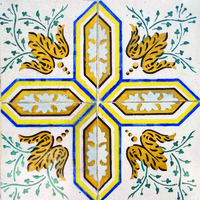Azulejaria Portuguesa no Rio de Janeiro dos séculos XVIII e XIX: um estudo de caso das fases de produção
Herança de um passado colonial, a azulejaria portuguesa na cidade do Rio de Janeiro possui raros exemplares que datam do século XVII presentes na antiga portaria do Mosteiro de São Bento, entretanto é no XVIII e no XIX que seu uso torna-se mais difundido. Inicialmente utilizada como revestimento decorativo e educativo-religioso em igrejas e con-ventos, no século XIX a azulejaria amplia o seu caráter utilitário, ao ser aplicada em hospitais e principalmente, em fachadas de edificações. É a partir deste novo uso que o azulejo se afirma no Brasil enquanto cultura somada. Os dois gêneros de azulejos aqui representados historiado e de padrão existentes no interior da Igreja Nossa Senhora da Penna e na fachada da edificação à rua Teófilo Otoni, 93 pertencem a diferentes fases históricas de produção: a artesanal e a semi-industrial. Estudar no âmbito do design os aspectos históricos, técnicos, formais e funcionais das fases representativas do azulejo português do XVIII e XIX presentes nestas edificações da arquitetura brasileira é o que este trabalho de dissertação se propõe.
Heritage of a colonial past, the Portuguese tiles in the city of Rio de Janeiro have rare pieces that date from the seventeenth century, present in the old lobby of the Monastery of St. Benedict, however it is in the XVIII and XIX that its use becomes more widespread. Initially used as a decorative and educational-religious coat of churches and convents, in the nineteenth century tiles extend their utilitarian character, when applied in hospitals and mainly in facades of buildings. It is from this new use that the tile is affirmed in Brazil as an added culture. The two types of tiles represented here - narrative and pattern - exist inside the Church Our Lady of Penna and on the facade of the building at Teófilo Otoni street, 93 belong to different historical phases of production: the artisanal and the semi-industrial. Studying in the scope of design the historical, technical, formal and functional aspects of the representative phases of the Portuguese tile of the XVIII and XIX present in these buildings of the Brazilian architecture is what this dissertation work proposes.
